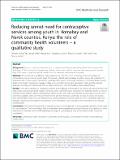Reducing Unmet Need for Contraceptive Services among Youth in Homabay and Narok counties, Kenya: The Role of Community Health Volunteers – A Qualitative Study
View/
Publication Date
5/1/2021Type
Article, Journalviews
downloads
Metadata
Show full item recordCitation
Ormel, H., Oele, G., Kok, M., Oruko, H., Oluoch, B., Smet, E., & Indalo, D. (2021). Reducing unmet need for contraceptive services among youth in Homabay and Narok counties, Kenya: the role of community health volunteers – a qualitative study. BMC Health Services Research, 21.
Abstract/
Background: Access to contraceptive services is a cornerstone of human well-being. While Community Health Volunteers (CHVs) promote family planning in Kenya, the unmet need for contraceptives among youth remains high. CHVs seem to pay little specific attention to the contraceptive needs of the youth. Methods: We conducted a qualitative study exploring the role of CHVs in increasing access and uptake of contraceptive services among youth aged 18–24 years in Narok and Homabay Counties, Kenya. We undertook 37 interviews and 15 focus group discussions involving CHVs, youth, community members, community leaders, youth leaders and health programme managers. Data were recorded, transcribed, translated, coded and thematically analysed, according to a framework that included community, CHV and health system-related factors. Results: CHVs often operated in traditional contexts that challenge contraceptive use among unmarried female and male youth and young married couples. Yet many CHVs seemed to have overcome this potential ‘barrier’ as well as reigning misconceptions about contraceptives. While private and facility-based public contraceptive services were somehow available, CHVs were the preferred service provider for many youth due to ease of access and saving time and transport costs. This was influenced by varied perceptions among youth of CHVs’ knowledge, skills and attitudes regarding contraceptives and provider-client interaction, and specifically their commitment to maintain confidentiality. Conclusions: CHVs have the potential to increase access to contraceptives for young people, reducing unmet need for contraceptives. Their knowledge, skills and attitudes need strengthening through training and supervision, while incentives to motivate them and broadening the range of contraceptives they are allowed to offer should be considered.
Subject/
Community health volunteers; Community health workers; Contraceptive services; Family planning; Youth; Kenya
Further Details
© The Author(s). 2021 Open Access This article is licensed under a Creative Commons Attribution 4.0 International License, which permits use, sharing, adaptation, distribution and reproduction in any medium or format, as long as you give appropriate credit to the original author(s) and the source, provide a link to the Creative Commons licence, and indicate if changes were made. The images or other third party material in this article are included in the article's Creative Commons licence, unless indicated otherwise in a credit line to the material. If material is not included in the article's Creative Commons licence and your intended use is not permitted by statutory regulation or exceeds the permitted use, you will need to obtain permission directly from the copyright holder. To view a copy of this licence, visit http://creativecommons.org/licenses/by/4.0/. The Creative Commons Public Domain Dedication waiver (http://creativecommons.org/publicdomain/zero/1.0/) applies to the data made available in this article, unless otherwise stated in a credit line to the data.
Publisher
Springer NatureCollections
- General - GEN [367]

